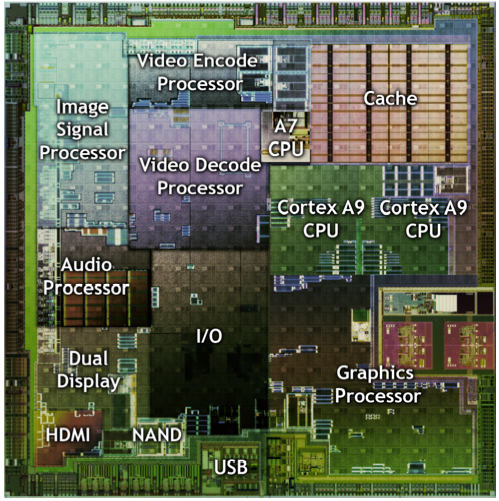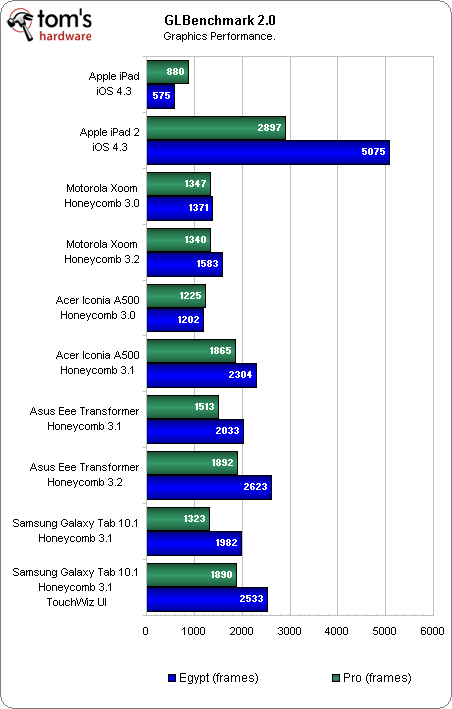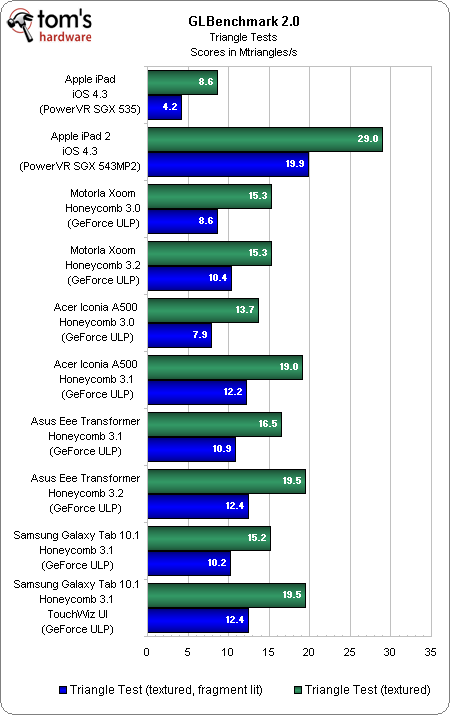Samsung Galaxy Tab 10.1: A Second-Gen Android Tablet
GPU Performance: Tegra 2
As we’ve mentioned in the past, mobile devices like smartphones and tablets use what’s known as a system-on-chip (SoC). This integrates the processor, GPU, RAM, and several other subsystems onto single device. Since all of those components sit next to each other on the same chip, there is greater efficiency in data transfers, while reducing the amount of space consumed on the PCB.
| SoC | Apple A4 (iPad) | Apple A5 | Nvidia Tegra 2 |
|---|---|---|---|
| Tablets | Apple iPad | Apple iPad 2 | Acer Iconia Tab A500Asus Eee Pad TransformerMotorola XoomSamsung Galaxy Tab 10.1 |
| Processor | 1 GHz ARM Cortex-A8 (single-core) | 1 GHz ARM Cortex-A9 (dual-core) | 1 GHz ARM Cortex-A9 (dual-core) |
| Memory | 256 MB 333 MHz LP-DDR (single-channel) | 512 MB 1066 MHz LP-DDR2 (dual-channel) | 1 GB 667 MHz LP-DDR2 (single-channel) |
| Graphics | PowerVR SGX535 (single-core) | PowerVR SGX545MP2 (dual-core) | ULP GeForce (single-core) |
| L1 Cache(Instruction/Data) | 32 KB / 32 KB | 32 KB / 32 KB | 32 KB / 32 KB |
| L2 Cache | 640 KB | 1 MB | 1 MB |
Tegra is Nvidia’s SoC brand, and it symbolizes the company’s effort to tap into the mobile market beyond its desktop-derived GeForce graphics processors. For those unfamiliar with Tegra 2, read page eight of our Motorola Xoom review for a full discussion GPU architecture. On the CPU side, Tegra 2 shares the same dual-core Cortex-A9, which offers a substantial boost from Cortex-A8 used in the first-generation iPad. Read Apple's iPad 2 Review: Tom's Goes Down The Tablet Rabbit Hole for a full discussion of Cortex-A9 performance.
While we've already covered Tegra 2, it's important to examine the graphics performance of each tablet. Sy Choudhury, director of product management at Qualcomm, once stated, "There is a misconception that the same processor and operating system gives the same performance." That's a phenomenon found on every tablet and smartphone. Why is it wrong to expect the same performance from all Honeycomb-based Tegra 2 tablets? Hardware vendors get access to the same optimizations from the SoC developer, but not all of the software-based tweaks are enabled by OEMs.
| GPU (System-on-Chip) | PowerVR SGX 535 (Apple A4) | PowerVR SGX 543 (Apple A5) | ULP GeForce (Tegra 2) |
|---|---|---|---|
| SIMD | USSE | USSE2 | Core |
| Pipelines | 2 (unified) | 4 (unified) | 8 (4 pixel / 4 vertex) |
| TMUs | 2 | 2 | 2 |
| Bus Width (bit) | 64 | 64 | 32 |
| Triangle rate @ 200 MHz | 14 MTriangles/s | 35 MTriangles/s | ? |
The ULP GeForce has a maximum operating frequency of 300 MHz, but device vendors can tweak this setting to save on power. Nvidia provides less information on the Tegra 2 than it does for its desktop GPUs, so it’s best to move on to benchmarks. As in our iPad 2 review, we're turning to GLBenchmark 2.0.
In terms of frames rendered in a set period, the Galaxy Tab 10.1 performs as well as other Android-based tablets running Honeycomb 3.1. Interestingly, the TouchWiz UI update enables graphics performance closer to the Eee Pad Transformer with Honeycomb 3.2. This implies one of two possibilities.
- Samsung could be enabling performance enhancements in the UI update.
- The TouchWiz UI is less resource-intensive than Honeycomb 3.1.
Whatever the reason, the Galaxy Tab 10.1 leads the pack as the best-performing Tegra 2-based tablet.
If you want to go into more depth than what is provided here, the full results of GLBenchmark 2.0 have been posted on Google Docs.
Get Tom's Hardware's best news and in-depth reviews, straight to your inbox.
Current page: GPU Performance: Tegra 2
Prev Page Synchronizing And USB Debugging Next Page Display Quality: Color Gamut-
killerclick No surprises here, iPad 2 is still on top, being the engineering masterpiece that it is. Take a look at side-by-side comparisons of iPad 2 and Galaxy Tab 10.1 on YouTube and you'll see how much smoother animations and video recording are on the iPad 2.Reply -
Martell77 I'm going to be in the market to buy about 150 tablets soon and from this article it appears that the ASUS 3.2 is the best all around for price/performance/recharge. While it doesn't win alot, it appears to be a consistant performer and has a relativly short recharge time.Reply
Or am I missing something here? -
dthx The reason why Samsung doesn't want to lower it's price is easy to understand: there are many (stupid) persons who are convinced that the iPad is superior to any other tablet just because it's priced higher... Samsung wants to make sure they capture that part of the market.Reply
But the author is right: if there is one reason Apple should sue Samsung, it's for copying the price structure of the iPad! -
Haserath Samsung Galaxy Tab needs a split keyboard feature in portrait mode; it isn't comfortable enough to have to stretch to hit the virtual keys.Reply
The 10.1 is still too slow for certain browsing. Flash is good as long as you don't want to rewind or fast forward through it. It sometimes slows down when I try typing also.
Since Apple produces both hardware and software, they can optimize their OS for the exact hardware they put out.
After trying the Samsung Galaxy Tab 10.1, I would say it's just a little too immature still. A good year or two and tablets will be perfect for browsing, gaming, and some other tasks while also being lightweight and easy to use even compared to laptops. -
Hmmm, many talk about iPad dominance but don't know all the facts. Just looking at a device in the store doesn't cut it folks. Android tablets are going to start cutting into market share, like it or not. For an IT person or true techie, most would choose an Android tablet. 4 core coming soon and they are going to rock the scene. Example: my Acer Iconia costs quite a bit less than iPad2.Reply
-Full USB port for mouse, keyboard, portable hard disks/thumb drives, cameras
-Overclocked and stable dual core CPU @ 1.504 Ghz (big change in performance)
-Customizable and open operating system (and it's going to get better with ICS)
-Honeycomb 3.2
-Netflix and Hulu working
-Mount drives from Linux, Windows, and OSX
-Websites with Flash that look the same as on a PC browser (now theres a concept)
-Wide screen 16:9
-5MP rear camera + front facing camera.
-HDMI out
-Charges back up in 1hr
-
dennisburke Price, proprietary cable management, and lack of expandable storage all lead me to want to wait to see what happens after Windows 8 becomes available.Reply


